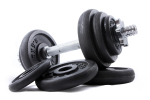|
2003/01/27, 11:09 AM
Hi
I've been wondering... is it better to do a bench press under control, up and down, or when you're pushing up, to put all you have into it and then lower it slowly?
When i try this, it takes the same amount of time to push it up further into a set when i'm doing it slowly than it is if i was explosively pushing it up. Which one should i do, is there much of a difference, and what will each one do?
Thanks
Peter
|
|
|
|
2003/01/27, 11:42 AM
What are you trying to accomplish? Are you training for looks or for strength?
Generally speaking, training for speed at about 50-60% your 1RM is a fantastic way to train for power and strength. This is how one of my training cycles go.
But training with slow negatives/fast positives, or slow negatives/slow postives is great for bodybuilders. Any comments from the BBs on the board?
--------------
Michael
"Trample the weak; hurdle the dead!"
|
|
2003/01/27, 12:15 PM
I, personally, think that slow concentrics (lifts) aren't optimal unless you're training for a sport that requires sustained contractions (such as wrestling or jujitsu). The way I see it is you end up training your muscles to be slower and you lose explosiveness which is generally helpful.
--------------
"Don't follow leaders and watch your parking meters!"
-- Bob Dylan
|
|
2003/01/27, 12:25 PM
Thanks Rev8ball and Mackfactor. I'm training for looks and strength. What do you mean by slow negatives/fast positives and stuff? I don't know my one rep max, but i probably will when i join a gym because i don't have enough weight at home to test it.
Peter
|
|
2003/01/27, 12:41 PM
In high school our coach told us it should take 5 seconds to extend and 7 seconds to contract our muscles. What are the advantages in this type of rep?
Also my coach's quote would be, "We're not lifting weights, we're building muscle"
Wyllyam
|
|
2003/01/27, 12:57 PM
============
Quoting from wyllyam:
In high school our coach told us it should take 5 seconds to extend and 7 seconds to contract our muscles. What are the advantages in this type of rep?
Also my coach's quote would be, "We're not lifting weights, we're building muscle"
Wyllyam
=============
What sport was this for and what position (if applicable)?
As for the quote, coach has it backwards. The majority of muscle building is done on the eccentric, or negative (lowering) phase of weight training. This is why slow negatives induce the most hypertropy in normal circumstances. Aside from that, in lifting weights, you're actually breaking down your muscles, you're building nothing. Muscle building is done on recovery days with rest and food.
--------------
"Don't follow leaders and watch your parking meters!"
-- Bob Dylan
|
|
2003/01/27, 01:17 PM
The "super slow" method that some teach will rob you of power and strength, whether you are a power lifter or a bodybuilder. ALWAYS strive to do more. This means heavy, explosive lifts. This is what taxes the muscle, achieving overload, thus growth. With the super slow method, you may feel the weight somewhat on each rep, but you will never go up in weights. More weight equal more strength which equals...well, you get it.
--------------
Failing to plan is like planning to fail!
|
|
2003/01/27, 01:20 PM
This was for the Basketball team. My position was guard. When the football team had the gym it was basically an all out competition of who could lift the most. The small peopole on the team would lift to increase there max.
And I think the coaches point behind the quote is there is a technique and a purpose to lifting weights which was building muscle. But thanks for the correction.
Wyllyam
|
|
2003/01/28, 12:28 PM
Thanks everyone
|
|
2003/01/28, 05:11 PM
If i take lets say 1 second to lift the weight up, and then i take 2 seconds to bring it down, will it stop me from going up in reps? Or would i need to go way slower.
I heard u should always take twice as long bringing the weight down then when u bring it up.
|
|
2003/01/28, 05:29 PM
i think 1 up and 2 down is ok, you'll still progress, i'm doing ok and that's about what i do. You can improve the number of reps and weight you can handle using the weight stripping method: Loading weight onto the bar, an when you fail, take a bit of weight off, immediately carry on and repeat.
|









